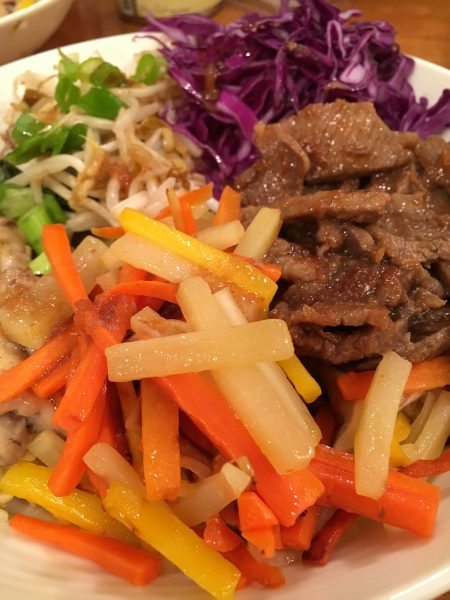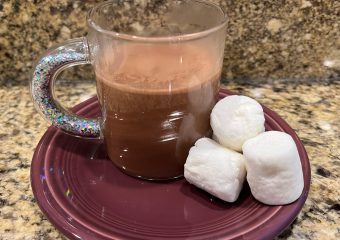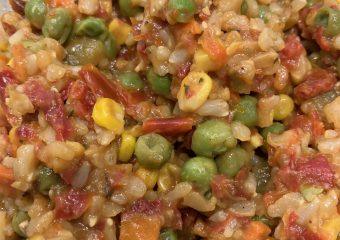
Simple Seoul Bibimbap and Marinade (adapted from Sunny Anderson)
2 pounds boneless beef rib-eye steak (or chicken, pork, or shrimp)
2 tablespoons plus 2 teaspoons packed light brown sugar
Pinch of red pepper flakes
1 clove garlic, finely grated
1/2 teaspoon finely grated peeled ginger
1/4 cup grated Vidalia or other sweet onion (use the largest holes on a box grater)
1/4 cup applesauce
2 teaspoons vegetable oil
1/3 cup soy sauce
Freshly ground pepper
For the vegetables and rice:
3 tablespoons vegetable oil
4 cups shredded or julienned carrots
1 pound shiitake or mixed wild mushrooms, stemmed and sliced
Kosher salt
1 bunch spinach, stemmed and chopped
1 teaspoon apple cider vinegar
4 to 6 tablespoons gochujang (fermented chile paste)
6 cups cooked white rice, hot
2 cups thinly sliced red cabbage (use a mandoline if you have one)
2 scallions, thinly sliced on the bias
4 cups bean sprouts
1/4 cup kimchi, thinly sliced or chopped
4 large egg yolks
Prepare the beef: Freeze the beef 30 minutes, then slice paper-thin. Whisk the brown sugar, red pepper flakes, garlic, ginger, onion, applesauce, vegetable oil, soy sauce and a few grinds of pepper in a large bowl until the sugar dissolves. Add the beef and stir to coat; cover and refrigerate 2 hours.
Preheat the oven to 375 degrees F. Place 4 dolsot stone bowls or two 10-to-12-inch cast-iron skillets in the oven to preheat, 30 minutes.
Cook the beef: Heat a cast-iron grill pan over medium-high heat. Remove the beef from the marinade and shake off the excess. Add the beef to the pan (you may have to do this in batches-be careful not to overcrowd the pan or the beef will steam). Cook without moving the meat, about 2 to 3 minutes on the first side. Flip and cook 1 more minute. Remove to a plate and cover with foil.
Cook the veggies: Combine 1 tablespoon vegetable oil and the carrots in a large skillet over medium-high heat. Cook, tossing, until the carrots are slightly tender but still crisp, just under 1 minute. Transfer to a large plate in a pile, leaving space for the other ingredients. Add 1 more tablespoon vegetable oil to the same pan; add the mushrooms and cook until they wilt and begin to brown slightly, about 2 minutes. Season with salt and transfer to the plate. Add the remaining 1 tablespoon vegetable oil and the spinach to the pan. Cook, stirring, until wilted, 1 minute, then add the vinegar and cook until completely evaporated, about 30 seconds. Place the spinach on the plate with the rest of the vegetables.
Assemble the bibimbap: Mix the gochujang with 1 tablespoon water in a small bowl; set aside. Remove the preheated bowls or skillets from the oven to a heat-safe surface, like a wooden cutting board. Add equal amounts of hot rice to each pot. (The rice must be piping hot in order to cook the egg yolk when you stir it in.) Add equal amounts of the remaining ingredients to each bowl or skillet in piles, clockwise in order: beef, carrots, mushrooms, spinach, cabbage, scallions, bean sprouts and kimchi. Drop a dollop of the gochujang mixture in the center of each bowl or skillet, then drop the egg yolks right on top of it (1 yolk per individual bowl or 2 yolks per skillet). Serve immediately, while the rice is still sizzling, and stir to combine all of the ingredients before eating.







Choose where to connect with us!